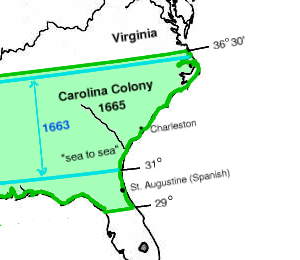Province of Carolina
|
|
The Province of Carolina from 1663 to 1729, was a North American British colony. In 1729 the new Province of Carolina was then divided into the Provinces of North and South Carolina. See British colonization of the Americas.
| Contents |
Brief history
Following the restoration of the monarchy in 1660, Charles II of England rewarded eight persons on March 24, 1663 for their faithful support in his efforts to regain the throne of England. He granted the eight grantees called Lords Proprietors or simply Proprietors the land was called Carolina, in honor of Charles I, the martyred father of Charles II.
1663 Charter
The 1663 charter granted the Lords Proprietor title to all of the land from the southern border of the Virginia Colony from 36 degrees north to 31 degrees north (along the coast of present-day Georgia). In 1665 the charter was revised slightly, with the northward boundary extended to 36 degrees 30 minutes north to include the lands of settlers along the Albemarle Sound who had left the Virginia Colony. Likewise the southern boundary was moved south to 29 degrees north, just south of present-day Daytona Beach, Florida, which had the effect of including the existing Spanish settlement at St. Augustine. The charter also granted all the land between from these bounds from the Atlantic to the South Seas.
Lords Proprietors
The Lords Proprietors named in the charter were: Henry Hyde, 2nd Earl of Clarendon, George Monck, 1st Duke of Albemarle, William Craven, 1st Earl of Craven, John Berkeley, 1st Baron Berkeley of Stratton, Anthony Ashley Cooper, 1st Earl of Shaftesbury, Sir George Carteret, Sir William Berkeley (brother of John), and Sir John Colleton. Of the eight, the one taking the most active interest in Carolina was Lord Shaftesbury, whose secretary, the philosopher John Locke, purportedly wrote a never-ratified constitution of Carolina. Some of the other Lords Proprietors also had interests in other colonies: William Berkeley in Virginia, John Berkeley and George Carteret in the Province of New Jersey.
The Lords Proprietors, while their authority was granted by royal charter, were nonetheless able to exercise that authority with nearly the power of an independent sovereign. The actual government consisted of a Governor, a powerful Council, half of which was appointed by the Lords Proprietors, and a relatively weak popularly elected Assembly.
The first permanent English settlement in the area was ten years earlier, in 1653, established mainly by emigrants from the Virginia Colony with others from New England and Bermuda. They settled on the banks of the Chowan and Roanoke Rivers in the Albemarle Sound area in the northeast corner of present-day North Carolina. This settlement came to be known in Virginia as "Rogues' Harbor".
In 1665, Sir John Yeamans, established a second permanent settlement on the Cape Fear River, near present-day Wilmington, North Carolina, called Clarendon.
Another region was settled under the Lords Proprietors in 1670 to the south of the other settlements, around present-day Charleston, South Carolina. The Charleston settlement developed more rapidly than the Albemarle and Cape Fear settlements due to the advantages of a natural harbor and easy access to trade with the West Indies. Lord Shaftesbury specified the street plan for Charleston and the nearby Ashley and Cooper Rivers are named for him.
This southern settlement, which became known as Charleston, was the principal seat of government for the entire Province, though due to their remoteness from each other had operated more or less independently until 1691 with the appointment of Philip Ludwell as governor of both areas. From that time until 1708, the northern and southern settlements were under common government. The north continued to have its own assembly and council, the Governor resided in Charleston and appointed a deputy governor for the north. During this period, the two began to become known as North Carolina and South Carolina.
Dissent
From 1708 to 1710, due to dissent over attempts to establish an Anglican state church, the province was unable to agree upon elected officials and was without recognized and legal government. That coupled with the outbreak of war with the Tuscarora and the inability of the Lords Proprietors to act decisively led to separate governments for North and South Carolina. Some take this period as the establishment of separate colonies, but that does not officially occur until 1729, when seven of the Lords Proprietors sold their interests in Carolina to the Crown and both North Carolina and South Carolina became royal colonies. The eighth share was Sir George Carteret's, which had passed to his great-grandson John Carteret, 2nd Earl Granville. He retained ownership of a 60-mile wide strip of land in North Carolina adjoining the Virginia boundary, which became known as the Granville District. This district was to become a scene for many disputes up to the American Revolutionary War at which time it was seized.
Government under proprietary rule or under crown rule was similarly organized. The primary difference being who appointed the governing officials: the Lords Proprietors or the Crown.
See also
- British colonization of the Americas
- List of North Carolina Governors
- List of South Carolina Governors
- Province of North Carolina
- Province of South Carolina
External links
- Carolina Charter of 1663 (http://www.yale.edu/lawweb/avalon/states/nc01.htm)
- Carolina Charter of 1665 (http://www.yale.edu/lawweb/avalon/states/nc04.htm)
- Concessions and Agreements of the Lords Proprietors of the Province of Carolina, 1665 (http://www.yale.edu/lawweb/avalon/states/nc03.htm)de:Carolina (Provinz)

